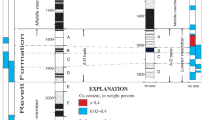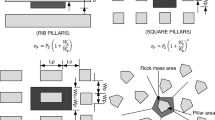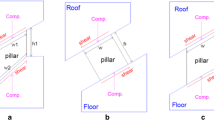Abstract
The sudden collapse of approximately 3 Ha of room-and-pillar workings at a limestone mine in southwestern Pennsylvania in 2015 resulted in an air blast that injured three mine workers. Subsequent investigations showed that an area encompassing 35 pillars had collapsed. The pillars were 9–10 m wide and up to 18 m high. A notable geologic feature is the through-going joints that dip at 50–80° and can extend from the roof to the floor of the pillars. These structures are thought to have weakened the pillars well below the strength that is predicted by empirical equations for hard-rock pillar design. This paper presents the relevant geotechnical data related to the collapsed area and numerical model results that were used to estimate the pillar loading underneath the variable topography, and compares the pillar loads to some established hard-rock pillar strength equations. The outcome is also compared to a strength equation that was developed specifically for limestone mines in which the negative impact of large angular discontinuities is explicitly accounted for. The results show that established hard-rock pillar strength equations do not adequately account for the impact of large through-going discontinuities on the strength of slender pillars. The equations would have significantly overestimated the strength of the pillars at the case study mine. The critical state of the workings would have been predicted correctly by the limestone pillar strength equation that accounts for the large discontinuities.






(photo by A. T. Iannacchione)





Similar content being viewed by others
References
ASTM D2938-95 (2002) Standard test method for unconfined compressive strength of intact rock core specimens. ASTM International, West Conshohocken, CA, 1995
Benardos AG, Kaliampakos DC, Prousiotis JG, Mavrikos AA, Skoparantzos KA (2001) Underground aggregate mining in Athens: a promising investment plan. Tunn Undergr Space Technol 16(4):323–329
Bieniawski ZT (1989) Engineering rock mass classifications. Wiley, New York
Brady BHG, Brown ET (2006) Rock mechanics for underground mining. Springer, Dordrecht
Dolinar D (2003) Variation of horizontal stresses and strains in mines in bedded deposits in the eastern and midwestern United States. In: Proceedings 22nd international conference on ground control in mining, 6–7 August 2003, Morgantown, USA, pp 178–185
Edmunds WE, Berg TM, Sevon WD, Piotrowski RC, Heyman L, Rickard RV (1979) The Mississippian and Pennsylvanian (Carboniferous) systems in the United States. USGS professional paper 1110-A-L
Elmo D, Stead D (2010) An integrated numerical modelling discrete fracture network approach applied to the characterization of rock mass strength of naturally fractured pillars. Rock Mech Rock Eng 43:3–19
Esterhuizen GS, Iannacchione AT, Ellenberger JL, Dolinar DR (2006) Pillar stability issues based on a survey of pillar performance in underground limestone mines. In: 25th international conference on ground control in mining, Morgantown, WV, pp 354–361
Esterhuizen GS, Dolinar DR, Ellenberger JL (2007) Observations and evaluation of floor benching effects on pillar stability in US limestone mines. In: 1st Canada–US rock mechanics symposium, American Rock Mechanics Association, Vancouver, BC, Canada, 27–31 May
Esterhuizen GS, Dolinar DR, Ellenberger JL (2011) Pillar strength in underground stone mines in the United States. Int J Rock Mech Min Sci 48(1):42–50
Gillespie P, Kampfer G (2017) Mechanical constraints on kink band and thrust development in the Appalachian plateau, USA, vol 458. Geological Society, London, pp 245–256 (Special Publication)
Hamrin H (2001) Underground mining methods and applications. Underground mining methods: engineering fundamentals and international case studies. In: Hustrulid WA, Bullock RL (eds) Society for Mining, Metallurgy, and Exploration, Inc., Littleton, Colorado, USA, pp 3–14
Hatcher RD, Thomas WA, Viele GW (eds) (1989) The Appalachian-Ouachita Orogen in the United States, vol F-2. Geological Society of America, Boulder, Colorado, p 275
Hedley DGF, Grant F (1972) Stope-and-pillar design for the Elliot Lake uranium mines. Bull Can Inst Min Metall 65:37–44
Hoek E, Brown ET (1980) Underground excavations in rock. England, Institute of Mining and Metallurgy, London, p 200
Iannacchione AT, Coyle PR (2002) An examination of the Loyalhanna limestone’s structural features and their impact on mining and ground control practices. In: Peng SS, Mark C, Khair AW, Heasley KA (eds) 21st international conference on ground control in mining, August 6–8, 2002, Morgantown, WV, pp 218–227
Iannacchione AT, Dolinar DR, Mucho TP (2002) High stress mining under shallow overburden in underground U.S. stone mines. In: First international seminar on deep and high stress mining, section 32. Australian Center for Geomechanics, Nedlands, Australia, 11 pp
Itasca Consulting Group (2004) Software: Universal distinct element code (UDEC) version 4.0, Minneapolis, Minnesota
Itasca Consulting Group (2012) Software: Fast Lagrangian analysis of continua in 3 dimensions (FLAC3D) Version 5.01, Minneapolis, Minnesota
Kerrigan R (2016) Structural geology of the southwestern section of the Appalachian Plateau: energy and environments: geology in the ‘Nether World’ of Indiana County, Pennsylvania. In: Guidebook for the 81st annual field conference of Pennsylvania Geologists, Indiana, Pennsylvania, Editors: Robin Anthony, pp 3–10
Krauland N, Soder PE (1987) Determining pillar strength from pillar failure observations. Eng Min J 8:34–40
Lunder PJ, Pakalnis R (1997) Determination of the strength of hard-rock mine pillars. Bull Can Inst Min Metall 90:51–55
Mark C, Gadde M (2008) Global trends in coal mine horizontal stress measurements. In: Proceedings 27th international conference on ground control in mining, WV University, Morgantown, USA, pp 319–331
Martin CD, Maybee WG (2000) The strength of hard-rock pillars. Int J Rock Mech Min Sci 37(8):1239–1246
Mount VS (2014) Structural style of the Appalachian Plateau fold belt, north-central Pennsylvania. J Struct Geol 69:284–303
Nickelsen RP, Hough VND (1967) Jointing in the Appalachian plateau of Pennsylvania. Geol Soc Am Bull 78(5):609–630
NIOSH (2018) Mining product: S-pillar—software for stone mine pillar design. National Institute for Occupational Safety and Health. https://www.cdc.gov/niosh/mining/works/coversheet1817.html. Accessed 16 Oct 2018
Oke J, Esterhuizen GS (2017) Improving hard rock pillar design by including rock mass classification and failure mechanisms. In: 51st US rock mechanics/geomechanics symposium, San Francisco, California, 25–28 June
Roberts D, Tolfree D, McIntyre H (2007) Using confinement as a means to estimate pillar strength in a room and pillar mine. In: 1st Canada–US rock mechanics symposium, American Rock Mechanics Association, Vancouver, BC, Canada, 27–31 May, pp 1455–1461
Rodgers J (1970) The tectonics of the Appalachians. Wiley, New York
Sak PB, McQuarrie N, Oliver BP, Lavdovsky N, Jackson MS (2012) Unraveling the central Appalachian fold-thrust belt, Pennsylvania: the power of sequentially restored balanced cross section for a blind fold–thrust belt. Geosphere 8(3):685–702
Trapp H Jr, Horn MA (1997) Ground water atlas of the United States—delaware, Maryland, New Jersey, North Carolina, Pennsylvania, Virginia, West Virginia. USGS Hydrologic Atlas 730-L
Zoback ML (1992) First- and second-order patterns of stress in the lithosphere: the world stress map project. J Geophys Res 97(11):703–711
Acknowledgements
The case study presented in this paper was conducted as part of the mission of NIOSH and MSHA to improve the safety of mineworkers. The authors wish to acknowledge the cooperation of the mining company in providing safe access to the mine after the collapse event and providing relevant geologic data and mine maps for the analysis. The thoughtful suggestions and comments of the reviewers, as well as their commitment to the rock engineering discipline, are acknowledged with thanks. This paper was published in an abbreviated form in the proceedings of the 52nd US Rock Mechanics Symposium, Seattle, Washington, USA, 17–20 June 2018, as paper no. 18-363.
Author information
Authors and Affiliations
Corresponding author
Ethics declarations
Conflict of interest
The authors declare that they have no conflict of interest.
Additional information
Publisher's Note
Springer Nature remains neutral with regard to jurisdictional claims in published maps and institutional affiliations.
Disclaimer
The findings and conclusions in this paper are those of the authors and do not necessarily represent the official position of the National Institute for Occupational Safety and Health, Centers for Disease Control and Prevention.
Rights and permissions
About this article
Cite this article
Esterhuizen, G.S., Tyrna, P.L. & Murphy, M.M. A Case Study of the Collapse of Slender Pillars Affected by Through-Going Discontinuities at a Limestone Mine in Pennsylvania. Rock Mech Rock Eng 52, 4941–4952 (2019). https://doi.org/10.1007/s00603-019-01959-6
Received:
Accepted:
Published:
Issue Date:
DOI: https://doi.org/10.1007/s00603-019-01959-6




